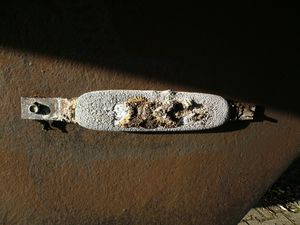مصعد گلڤاني
مصعد گلڤاني Galvanic anode أو الأنود القرباني هو أنود فلزي يستخدم في العمليات الكيميائية الكهربية، وغالبا ما يذوب كجزء من العملية.
ومثال لهذا هو الأنود الجلفاني المستخدم في أنظمة حماية الكاثود, والغرض من هذه العملية هو حماية فلز معين من التآكل (مثل حماية أجسام السفن الخارجية, حماية أنابيب نقل النفط, أو سخانات المياه) عن طريق جعل الأنود أكثر سالبية كهربية من الفلز المراد حمايته.
ومثال أخر للأنود القرباني هو الأنود المستخدم في عملية الطلاء الكهربي حيث يتم يستبدل الفلز الموجود في الأنود الفلز الموجود في محلول الطلاء والذى يترسب على الكاثود.
. . . . . . . . . . . . . . . . . . . . . . . . . . . . . . . . . . . . . . . . . . . . . . . . . . . . . . . . . . . . . . . . . . . . . . . . . . . . . . . . . . . . . . . . . . . . . . . . . . . . . . . . . . . . . . . . . . . . . . . . . . . . . . . . . . . . . . . . . . . . . . . . . . . . . . . . . . . . . . . . . . . . . . . .
النظرية
In brief, corrosion is a chemical reaction occurring by an electrochemical mechanism (a redox reaction).[1] During corrosion there are two reactions, oxidation (equation 1), where electrons leave the metal (and results in the actual loss of metal) and reduction, where the electrons are used to convert water or oxygen to hydroxides (equations 2 and 3).[2]
-
Fe → Fe2+ + 2e−
(1)
-
O2 + 2H2O + 4e− → 4OH−
(2)
-
2H2O + 2e− → H2 + 2OH−
(3)
In most environments, the hydroxide ions and ferrous ions combine to form ferrous hydroxide, which eventually becomes the familiar brown rust:[3]
-
Fe2+ + 2OH− → Fe(OH)2
(4)
مزايا وعيون حماية المصعد الگلڤاني
المزايا
- No external power sources required.
- Relatively easy to install.
- Lower voltages and current mean that risk of causing stray current interference on other structures is low.
- Require less frequent monitoring than impressed current CP systems.
- Relatively low risk of overprotection.
- Once installed, testing the system components is relatively simple for trained personnel.
العيوب
- Current capacity limited by anode mass and self consumption at low current density.
- Lower driving voltage means the anodes may not work in high-resistivity environments.
- Often require that structure be electrically isolated from other structures and ground.
- Anodes are heavy and will increase water resistance on moving structures or pipe interiors.
- Where D.C. power is available, electrical energy can be obtained more cheaply than by galvanic anodes.
- Where large arrays are used wiring is needed due to high current flow and need to keep resistance losses low.
- Anodes must be carefully placed to avoid interfering with water flow into the propeller.
الكفاءة الاقتصادية
As the anode materials used are generally more costly than iron, using this method to protect ferrous metal structures may not appear to be particularly cost effective. However, consideration should also be given to the costs incurred by removing a ship from the water, for example, to repair a corroded hull or to replace a steel pipeline or tank because their structural integrity has been compromised by corrosion.
انظر أيضاً
الهامش
المراجع
- A.W. Peabody, Peabody's Control of Pipeline Corrosion, 2nd Ed., 2001, NACE International. ISBN 1-57590-092-0
- Schreir L.L. et al., Corrosion Vol. 2, 3rd Ed., 1994, ISBN 0-7506-1077-8
- Baeckmann, Schwenck & Prinz, Handbook of Cathodic Corrosion Protection, 3rd Edition 1997. ISBN 0-88415-056-9
- Det Norske Veritas Recommended Practice for Cathodic Protection Design DNV RP-B401-2005
